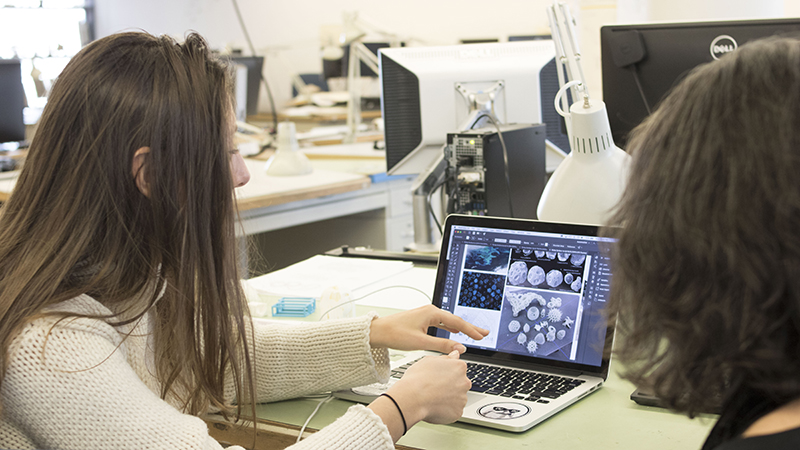Architecture & Urbanism

Smith’s architecture program combines studio work with courses in architectural history. In studios, students explore the built environment “as a person experiences it,” building models by hand, using laser cutters and designing with sophisticated computing technology. Classes on urban space, public architecture and landscape design complement studio work. Often students work on local projects and at the MacLeish Field Station in Hatfield.
All graduating Art majors and minors will:
- develop familiarity with original works of art and/or architecture and with research tools appropriate for the discipline, including print scholarship, online databases, and various reference materials;
- communicate their ideas effectively in written, oral and (as appropriate) material form, including public presentations that rely upon the display of visual images or artwork;
- engage a range of disciplines in their work, in the spirit of a liberal arts education.
Art Studio and Architecture majors and minors will:
- demonstrate fluency in practices or techniques in the current field of practice for at least one medium (e.g, painting, installation, photography, digital media);
- demonstrate proficiency in an extensive and pertinent vocabulary for describing their own work and the art historical antecedents with which it shares relationships;
- demonstrate familiarity with professional practices and global perspectives within the cultural landscape of contemporary art;
Assessment (majors and minors): Students will be assessed through periodic faculty and peer critiques of their work and reviews of their written and oral abilities.
Assessment (majors only): Students will create a body of work for final exhibition that results from deep engagement in the process of making and demonstrates an awareness of the contemporary and historical context in which the work exists. This work will be evaluated through peer, faculty, and external critique.
Students will also complete the major with a professional-level, documented portfolio of their work, including both visual and written materials.
Art History majors and minors will:
- learn to read original objects, architectural settings, and written scholarship analytically and synthetically;
- demonstrate familiarity with the different ways that spaces, monuments, and objects have intersected with lived and imagined experiences throughout history and the world over;
- demonstrate expertise in self-directed research, including fluency with a range of methodologies and debates across the discipline.
Assessment: Students will be assessed in classes, through faculty reviews of their written and oral abilities.
Students will also complete a capstone research seminar that results in a sustained piece of original research to be evaluated by the faculty.
Advisers
Yanlong Guo, Barbara Kellum, Elisa Kim, Dana Leibsohn, John Moore, and Frazer Ward.
Requirements
Students entering Smith College in the Fall 2020 semester (or after) are subject to the following requirements. All others have the option of following this set of requirements or the one in effect when they arrived at the college or declared their major.
Requirements: 12 courses, which will include:
1. ARH 110 Art and Its Histories
2. One 100-level course selected from the following:
ARS 162, ARS 163, or ARS 172
3. Both of the following introductory architectural design studios:
ARS 280 and ARS 281
4. One of the following advanced architectural design studios:
ARS 380 or ARS 381
5. One studio art course in another medium
6. Three 200-level or 300-level art history courses focusing on the built environment (of which at least one must focus on a pre-1800s era and at least one must focus on the post-18th century)
7. Two architecture-focused elective courses (to be selected with guidance from advisor)
8. One art history research-focused seminar (with final paper focusing on the built environment, to be taken at Smith)
It is recommended that a student contemplating application to a graduate program in architecture take at least one semester of physics and at least one semester of calculus, after consultation with her major adviser.
**In response to the current unprecedented circumstances, the Department of Art is allowing up to two Satisfactory/Unsatisfactory (S/U) courses from Academic Year 2020–21 to count towards the major.**
Advisers
Yanlong Guo, Barbara Kellum, Elisa Kim, Dana Leibsohn, John Moore, and Frazer Ward.
Designed for students who wish to focus on architecture, although they are majors in another department. This minor seeks to introduce students to the history, design and representation of the built environment.
Requirements:
1. Three courses, selected from this list:
- ARS 162, ARS 163 or ARS 172
- ARS 280 or LSS 250
- ARS 281 or LSS 255
2. Two 200-level or 300-level art history courses focusing on the built environment (of which at least one must focus on a pre-1800s era and at least
one must focus on the post-18th century).
3. ARH 110 Art and Its Histories
Director of Honors, Architecture and Urbanism
Elisa Kim (Fall 2020), Frazer Ward (Spring 2021)
The college's official requirements, guidelines and deadlines are available on the class dean's website.
Every year the art department organizes an informational meeting about honors, an 8-credit class focused on independent research. We strongly encourage interested students to attend this discussion of important deadlines and the timeline for applications. Department guidelines and practices related to honors can be found on the art department's honors page.
Honors
Architecture & Urbanism Director of Honors: Elisa Kim (Fall 2021), Frazer Ward (Spring 2022)
Every year the art department organizes an informational meeting about honors, an 8-credit class focused on independent research. We strongly encourage interested students to attend this discussion of important deadlines and the timeline for applications. The college’s official requirements, guidelines and deadlines are available on the class dean’s website.
Requirements
All candidates will present their work in a public presentation to the art department, in late in April or early May.
Who Qualifies for Honors?
Students wishing to apply must have:
- At least a 3.4 grade point average (GPA) through the junior year in all courses in the major
- At least a 3.3 GPA through the junior year in all courses outside the major
Only Smith College courses (including Picker and Smithsonian), Five College and Smith College Junior Year Abroad (Florence, Geneva, Hamburg, Paris) are counted in the GPA. Smith College grades from the first year are counted in the GPAs outside and inside the major.
To be considered for art department honors, you must have a strong academic background both in general and in your art major. You must be able to work independently, and you must have thought long and hard about your project. By the time you submit your application, the proposal needs to be clearly, fully and specifically developed.
The 8 credits of the honor thesis "count" as art department credits (i.e., they constitute part of the 64 credits in the major). This is one of the reasons why many ambitious and accomplished students choose not to do honors; they find they would rather take other classes—either in art or other departments—to broaden their background.
Financial Support
The Nancy Kershaw Tomlinson Memorial Fund offers financial support to offset some of the expenses related to the honors thesis project. Your request for funding needs to be included with the application.
Thesis & Presentation
The thesis will count for 60 percent of the honors designation. For ARH, the expected length of the thesis is about 60-80 pages (excluding bibliography). For ARS/ARU students this will be based on work through the year and final exhibition. The final Jannotta Gallery exhibition must consist of work that comprehensively addresses and resolves the thesis topic. It must be installed in a manner that demonstrates best professional practices. In the case of site-specific work outside the gallery, there must be a Jannotta Gallery exhibition component comprising of appropriate documentation materials.
The oral component will count for 20 percent of the honors designation. This is comprised of a public presentation and a defense. Usually scheduled on the Monday of the last week of classes, honors students are required to give a formal presentation of their work and field questions on their project. This event is public, members of the department will attend and students are encouraged to invite friends and family. The directors of honors and advisers will rehearse the presentation with you during the spring semester. During the examination period, students are required to participate in a defense. For ARH, students are asked to briefly summarize the findings of their thesis and field questions from the members of the thesis committee as well as any other member of the art department who has read the thesis. For ARS/ARU, this will consist of a critique of the final exhibition with the members of the thesis committee.
Evaluation
Your thesis adviser and second reader each provide an honors designation (highest honors, high honors, honors, pass, or fail). If they substantially disagree, a third/fourth reader is assigned by the director of honors in consultation with the department.
In the art department the honors designation is determined as follows:
Thesis: 60 percent
GPA in the major: 20 percent
Presentation/defense: 20 percent
Consulting & Advising
Copies of recent, successful proposals are on file in the art department office for consultation. These may be read in the office, even consulted several times, but not copied.
The directors of honors for the department are available to meet students at the initial stages of the process—during when the application is being assembled as well as throughout the year when the honors project is underway.
It is your responsibility to find a full-time faculty member in the art department who will work with you for the year as your thesis adviser and who has the relevant expertise. In consultation with you, the director of honors will appoint a second or third reader (for ARS/ARU students, the committee usually consists of two studio members and one art historian; for ARH students, a committee of two members is usually the norm but if the nature of the project requires further expertise it might include an additional member). The committee members do not all have to be from the art department and might include faculty from the other institutions in the Five College consortium. The committee needs to be in place by October 15.
Honors students must carry a minimum course load of 12 credits in each semester of the senior year.
During the fall semester of your thesis, you will be meeting regularly (typically every other week) with your adviser.
You are also expected to schedule an appointment with the art librarian early in the fall (see college requirements for honors). In December, you are required to schedule a meeting with your director of honors to report on your progress.
All art department honors students must complete draft (whether written or visual*) of the thesis to their thesis adviser by February 15 (or the following Monday, should it fall on a weekend). Failure to do so will result in the conversion of the 8-credit Honors Thesis to two distinct 4-credit Special Studies. Your adviser and the second reader will offer extensive comments on this draft; on the basis of these comments, honors students work independently to revise their theses. The final version of the thesis is due mid-April (as set by college requirements for honors).
*The first draft for ARS and ARU students should consist of an exhibition plan detailing number, sizes and nature of work to be installed.
Applying for Honors
The art department expects students to submit their proposals at the end of the second semester of the junior year, so that it may consider the projects during its last meeting in early May.
The department may approve, provisionally approve, or not approve the proposal. If the approval is provisional, students will be asked to revise the proposal and resubmit it for final approval; if not approved, students may still present a new proposal the following fall (however, without the benefit of time for revision).
At the latest, your application must be submitted one week before the first Department meeting of the fall semester (usually this meeting takes place before or close to September 15). Once approved, proposals are sent to the College Subcommittee on Honors and Independent Programs (SHIP) for final approval (mid to late September). The final decision regarding admission to the honors program rests with that committee.
All applications must include:
-
College form with GPA. Calculate, together with the thesis adviser, the separate grade point averages (GPAs) inside and outside the major for all courses on the official form, which you can request via e-mail at: honors@smith.edu. Instructions on how to calculate will be sent together with the calculation form. This process requires time, and requests for forms should be made well before the art department's deadlines.
-
Submit to the appropriate director of honors (ARH; ARS/ARU) a thesis proposal consisting of 500 to 1,000 words (two to four pages) containing:
- A description of the broader scholarly issue to be investigated
- The specific question or hypothesis to be treated
- An explanation of the approach to be taken and evidence of experience using this approach
- In the case of ARS and ARU students, discussion of the expected end project: its form, scale and scope, and examples of relevant art work
- Documentation of relevant background, preparation, special facility or skills necessary to undertake the proposed thesis (e.g., previous course work related to the thesis topic, quantitative skills, foreign language ability, etc.)
You do not need to register for the honors course: If admitted, the registrar will automatically add that to your roster of courses. However, you do need to register for the honors course for second semester.
Study Abroad
Many art majors choose to study in other countries, which we encourage. Visit the Study Abroad website for more details about Smith’s programs.






